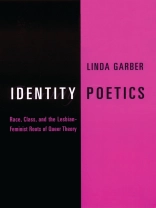‘Queer theory, ‘ asserts Linda Garber, ‘alternately buries and vilifies lesbian feminism, missing its valuable insights and ignoring its rich contributions.’ Rejecting the either/or choice between lesbianism and queer theory, she favors an inclusive approach that defies current factionalism. In an eloquent challenge to the privileging of queer theory in the academy, Garber calls for recognition of the historical—and intellectually significant—role of lesbian poets as theorists of lesbian identity and activism.
The connections, Garber shows, are most clearly seen when looking at the pivotal work of working-class lesbians/lesbians of color whose articulations of multiple, simultaneous identity positions and activist politics both belong to lesbian feminism and presage queer theory. Identity Poetics includes a critical overview of recent historical writing about the women’s and lesbian-feminist movements of the 1970s; discussions of the works of Judy Grahn, Pat Parker, Audre Lorde, Adrienne Rich, and Gloria Anzaldúa; and, finally, a chapter on the rise and hegemony of queer theory within lesbigay studies.
Daftar Isi
Introduction: Race, Class, and Generations
1. The Social Construction of Lesbian Feminism
2. Putting the Word Dyke on the Map: Judy Grahn
3. ‘I Have a Dream Too”: Pat Parker
4. ‘High Over the Halfway Between Your World and Mine”: Audre Lorde
5. An Uncommonly Queer Reading: Adrienne Rich
6. ‘Caught in the Crossfire Between Camps”: Gloria Anzaldúa
7. Around 1991: The Rise of Queer Theory and the Lesbian Intertext
Afterward, March: June 24, 2000, San Francisco
Works Cited
Tentang Penulis
Linda Garber is associate professor in the department of English and the Program for the Study of Women and Gender at Santa Clara University. She is the editor of
Tilting the Tower: Lesbians/Teaching/Queer Subjects and the author of articles on lesbian literary criticism and lesbian studies.












